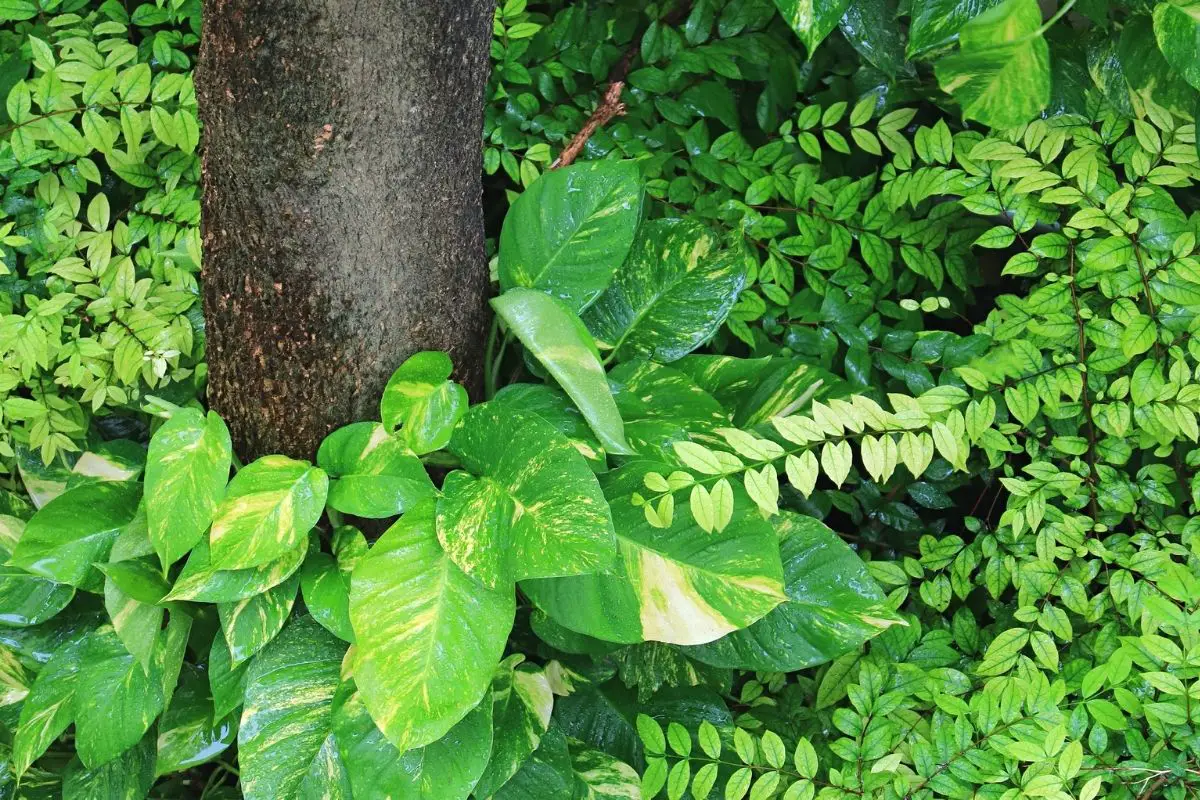Golden ivy is an absolutely amazing indoor plant! It can make a stunning addition to any home, office, or public space. But did you know, you can also grow Epipremnum aureum outside?
With the right care and attention, pothos plants can make your garden and backyard look like a beautiful tropical jungle.
Here is everything you need to know about growing pothos outdoors!
Can Pothos Grow Outside?
Absolutely! Devil’s ivy can be grown outside directly in the ground, in an outdoor hanging basket, or on a garden trellis.
Pothos Outside Temperature Requirements
In order for your ivy to grow outdoors healthily, you need to live in USDA hardiness zones 10 and 11.
Pothos needs to stay in an environment between 60 and 80 degrees Fahrenheit. Although it can survive a few cold shocks, once it gets below 50 degrees Fahrenheit, its roots may permanently freeze.
If you live outside of these hardiness zones, you can always grow your golden pothos outside during the summer and then bring it inside during the winter. Once the heat reaches 90 degrees Fahrenheit and above, the ivy will have a difficult time growing. As long as the heat stays below 90 degrees Fahrenheit for the majority of the summer season, your ivy should be very prosperous!
Pothos Flowering Outside
In their natural habitat, devil’s ivy can grow small cream, pink, and purple coloured flowers. If you plant your ivy outside, you may start to notice these flowers bloom during the spring and summer months.
Once your Epipremnum aureum reaches 30 feet, you will surely begin to see these gorgeous flowers blossom! This is one huge advantage to growing your golden ivy outside.
Outdoor Pothos Care
The most important part of growing Epipremnum aureum outdoors is making sure the environment mimics its natural habitat. This can be easily achieved with proper sunlight, water, and soil.
Sunlight
Devil’s ivy needs to live in bright indirect light. When living outside, it’s crucial for these plants to have partial shade. This will prevent them from drying out and getting sunburnt. Keep them away from direct sunlight and they should grow much quicker and healthier!
Water
The top 2 inches of soil should dry out between each watering. The amount you water your plant will be very dependent on how much sun and heat the plant is getting. Water about once every 5 to 10 days, but quickly check the soil first!
Soil
Epipremnum aureum can happily live in an all-purpose potting mix. Just like indoor golden ivy, outdoor golden ivy likes to grow in well-draining soil with slight acidity (pH 6.1-6.5).
FAQs
Can pothos live outside in the summer?
Devil’s ivy can live outside all summer long! Make sure to place your ivy in an area with partial shade so that the leaves don’t crack and burn in direct light.
Can pothos live outside in the winter?
As long as you live in an area that stays above 60 degrees Fahrenheit during the winter, your pothos can live outside. In colder areas, it’s best to keep your plant inside. Once it drops below 50 degrees Fahrenheit, your devil’s ivy will likely freeze.
Should I grow my pothos outside?
Pothos can thrive indoors or outdoors. If you live in USDA zones 10 and 11 and want your ivy to have space to grow as long as it does in its natural habitat, try growing it outside. Golden ivy will give your garden or backyard a beautiful jungle feel!
Can pothos recover from cold shock?
Devil’s ivy is very resilient and can eventually recover from cold shock. Even though they will lose most of their foliage, if their roots aren’t severely damaged, they can slowly grow back to normal.
Where should pothos be placed outside?
Pothos will thrive anywhere outside as long as it is not in the direct sunlight! Consider planting it next to a tree and watch it slowly climb all the way up.
~ image source: depositphotos/shinylion

